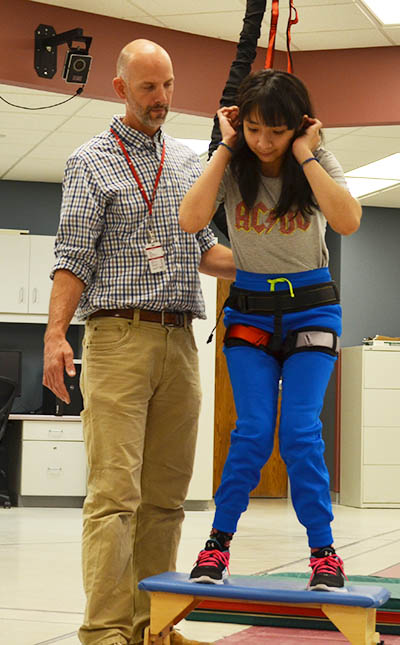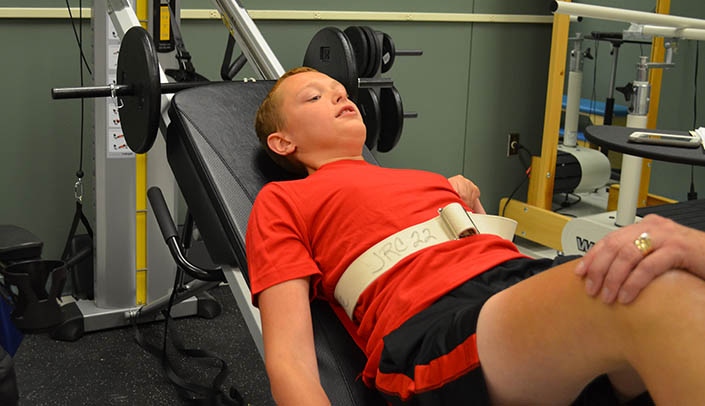UNMC’s Munroe-Meyer Institute (MMI) and Louisiana State University Health Sciences Center New Orleans (LSUHSC-NO) are collaborating on a study to compare two different types of physical therapy for youth with cerebral palsy.
Max Kurz, Ph.D., of the MMI Department of Physical Therapy, and Noelle Moreau, Ph.D., of LSUHSC-NO’s School of Allied Health Professions, are examining the benefits of power training, a treatment more related to muscular function, and an action-perception approach that stresses movement planning.
Seeking study participants
The Munroe-Meyer Institute currently is enrolling subjects for this study (IRB#557-15-EP). Contact Max Kurz, Ph.D., at 402-559-9599 or by email for more information.
“One of the problems that is pretty prominent in the literature for kids with cerebral palsy is that their muscles are not working very well,” Dr. Kurz said. “It could be that they’re weak, or they’re not generating muscular contractions as fast.
“But from our brain imaging data, we also find that kids have trouble planning the motor actions that they’re producing. So even before anything is generated, they have problems orchestrating to generate the output, which says that the problem is really in the planning period, and it spills over to the action.”
Dr. Moreau, who worked as a postdoctoral fellow with Diane Damiano, Ph.D. — considered a pioneer in strength training for children with cerebral palsy — said that muscle power seems to be a key ingredient for improving walking in kids with cerebral palsy.
“This project is comparing power training to action-perception training,” she said.
The investigators will use UNMC’s MEG to look at changes on the cortical level, where the power-training outcomes will be based on muscle plasticity.
 |
Brad Corr, D.P.T., left, helps Millie navigate an obstacle as part of her physical therapy during a new study. |
The key is comparing the beneficial results from both types of treatment, Dr. Kurz said.
“I think both paradigms will improve mobility, and that’s our big goal, to make kids better, more mobile so they can move within their communities and school,” he said. “But what we’re trying to see is how big a ‘bang for the buck’ are we getting with these two approaches.”
“It’s exploratory, but it’s pretty exciting,” Dr. Moreau said.
“Dr. Kurz is an amazing researcher, with great scientific instincts. He is very collaborative, and I am excited about this high-impact, exciting project with a talented collaborator such as Dr. Moreau,” said Karoly Mirnics, M.D., Ph.D., director of MMI. “The outcome of this collaborative research will have a huge impact on our understanding of sensorimotor processes, and has a potential to fundamentally change our patient care practices.”
At one session, Ethan, a high school junior with CP, was power-training with MMI physical therapist Heidi Reelfs. Using a specially designed weightlifting tool, he worked first the right leg, then the left, then both, straining to straighten them through sets of five reps, with Reelfs at times adding more weight.
“It’s good,” he said of the three-day-a-week regimen. “It’s better than being in the swimming pool. I don’t like putting my head under water.”
Kirstin, Ethan’s mother, said the study is an opportunity to do a different type of therapy.
“And it helps people learn how to treat and help people with cerebral palsy,” she said, adding that she’d noticed Ethan had increased strength in his legs.
“One of the interesting parts of the power-training program is that it really trains you like an athlete, and that approach is not used very often with kids with cerebral palsy,” Dr. Moreau said.
“We think that they have limitations in their abilities and can’t do as much. But we have Paralympic sports, and some of the athletes you see there, they push their limits and they’ve shown us that your abilities are limited to within,” Dr. Kurz said.
At a different session, teenager Millie is hooked to a harness suspended from the ceiling to help her support her weight as she works with Brad Corr, Ph.D., to complete the action-perception training.
Millie’s session is filled with laughter, as she teases Dr. Corr while working with him to move over and around various obstacles. At one point, after stepping down from atop a step, she admits. “That was just scary, when I stood up there and didn’t have any support.
“I could feel the floor,” she said after the session. “I haven’t felt the floor for a long time.”
Millie and Ethan’s physical therapy is very different, which is the point of the research.
“These are two really intriguing and exciting approaches,” Dr. Kurz said. “It will be interesting to see the outcome.”

Cerebral Palsy continues to affect many of our kids. Once thought “static”, we must be very proud of any effort to look into helping these little brains adapt and gain new functions. Kudos to Max, MMI, and UNMC